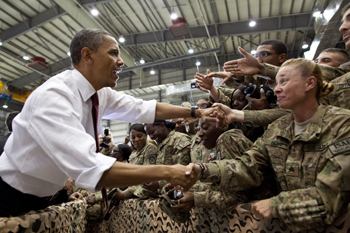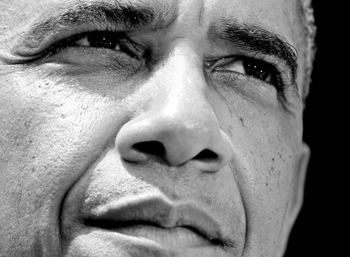Written by: Dr. Ilhan Niaz
Posted on: November 07, 2012 |  | 中文
| 中文
 David Sanger. Confront and Conceal: Obama’s Secret Wars and Surprising Use of American Power. New York: Crown Publishers, 2012. Pages: xx + 476. Price: US $ 28.00. Hardback. ISBN: 978-0-307-71802-0.
David Sanger. Confront and Conceal: Obama’s Secret Wars and Surprising Use of American Power. New York: Crown Publishers, 2012. Pages: xx + 476. Price: US $ 28.00. Hardback. ISBN: 978-0-307-71802-0.
David Sanger’s Confront and Conceal: Obama’s Secret Wars and Surprising Use of American Power is a fast-paced journalistic account of the first three years of the Obama presidency. Sanger, in addition to providing an enticing narrative, also attempts to determine the nature and dimensions of the “Obama Doctrine.” While the narrative is high-octane and quite absorbing, it is Sanger’s pursuit of the Obama Doctrine that sets Confront and Conceal apart from other accounts of Obama’s first term as US president.
Substantively, the Obama Doctrine applies realism to the projection of American power and regards the George W. Bush administration’s attempts to assert US dominance as hubristic and wasteful of vital time and resources. This realism lay at the heart of Obama’s assessment that US involvement in Afghanistan was futile if the went beyond the minimum required to prevent international terrorist organizations from regrouping there. Politically, the US had long lost the war because its local allies were incapable of providing real leadership to the Afghan people while public opinion in the West was unwilling to countenance the prospect of perpetual deployment and nation-building in Afghanistan. Economically, the nominal price tag of the war was steep and the cost to the United States in terms of distraction from domestic renewal was unacceptable. The surge that Obama authorized at the start of his presidency was meant to demonstrate that the US had done all it could within existing political constraints to help the Kabul regime while imposing an exit date to mollify public opinion at home and serve notice to its local allies that would soon have to deal with the Afghanistan situation on their own. Rationalizing US military commitments in Iraq and Afghanistan was thus the prime goal of Obama’s foreign policy. The first element of the Obama Doctrine that emerges is that offensive wars involving costly, open-ended occupations of other countries are not realistic options and the enlargement of objectives is to be avoided until strategic exhaustion is reversed.
 Exhaustion, owing to military over-stretch abroad and political and economic difficulties at home, meant that the Obama administration has been an enthusiastic practitioner of intelligence-based attacks on US enemies. Sanger describes how Obama was intimately involved in the development and deployment of cyber weapons, drones and special operations. The idea is to go after those entities and individuals that threaten US and allied interests, but do so in a way that is concealed. This approach is far cheaper in terms of blood and treasure, can be kept quiet for much longer, is often diplomatically more manageable than sanctions, and helps buy time. The use of cyber worms to disrupt Iran’s nuclear program is a particularly instructive illustration of this approach. In 2008, the US could not afford to get embroiled in a war with Iran and it knew that the Iranians were racing to acquire nuclear weapons capability. An Iran with such capability was unacceptable to both the United States and its regional allies. At the same time surgical aerial bombardment of Iranian facilities would not lead to the destruction of the program and provoke a conventional response elsewhere in the region. By employing cyber attacks to delay the Iranian program, Obama bought time to wind down the war in Iraq and set in motion the surge-and-exit strategy in Afghanistan. As the US military presence in Iraq and Afghanistan draws down, US military options against Iran will increase, for dismantling Tehran’s nuclear program will require troops on the ground to inhibit Iran’s conventional retaliation and secure its nuclear facilities. The second element of the Obama doctrine, therefore, is that US policy should methodically employ asymmetric and unconventional power to keep enemies off balance, provide alternatives to all out war, and secure breathing room.
Exhaustion, owing to military over-stretch abroad and political and economic difficulties at home, meant that the Obama administration has been an enthusiastic practitioner of intelligence-based attacks on US enemies. Sanger describes how Obama was intimately involved in the development and deployment of cyber weapons, drones and special operations. The idea is to go after those entities and individuals that threaten US and allied interests, but do so in a way that is concealed. This approach is far cheaper in terms of blood and treasure, can be kept quiet for much longer, is often diplomatically more manageable than sanctions, and helps buy time. The use of cyber worms to disrupt Iran’s nuclear program is a particularly instructive illustration of this approach. In 2008, the US could not afford to get embroiled in a war with Iran and it knew that the Iranians were racing to acquire nuclear weapons capability. An Iran with such capability was unacceptable to both the United States and its regional allies. At the same time surgical aerial bombardment of Iranian facilities would not lead to the destruction of the program and provoke a conventional response elsewhere in the region. By employing cyber attacks to delay the Iranian program, Obama bought time to wind down the war in Iraq and set in motion the surge-and-exit strategy in Afghanistan. As the US military presence in Iraq and Afghanistan draws down, US military options against Iran will increase, for dismantling Tehran’s nuclear program will require troops on the ground to inhibit Iran’s conventional retaliation and secure its nuclear facilities. The second element of the Obama doctrine, therefore, is that US policy should methodically employ asymmetric and unconventional power to keep enemies off balance, provide alternatives to all out war, and secure breathing room.
The world, of course, does not wait and as the Arab Spring erupted, world powers struggled to come to terms with the fall out. The United States also had to make rapid adjustments. Here, Obama adopted a case-by-case approach while making it clear that unilateral US military intervention to affect the outcome of struggles raging across the region was out of the question. By adopting an attitude of philosophical resignation the Obama administration forced its notoriously lethargic European allies to take the initiative against Libya. In Syria as well, the US refuses to be drawn in, for if the Turks and Saudis have the most to gain from rolling back Iranian influence, let them take the risks. This then is the vital third element in the Obama doctrine – give allies a longer leash to pursue their own interests and agendas while continuing to support them behind the scenes.
 There are two great challenges for the Obama Doctrine that exposes its limitations and might well determine his legacy. One is the rise of China. The other is the decline of Pakistan. In both cases the United States has few good long-term options. Managing China’s rise depends a great deal on the restraint that the Chinese and US leaderships display towards each other and thus far, both have been measured enough. What no one seriously doubts is that if China sustains its peaceful development for another generation, the US sphere of influence in East Asia will be history. This is not an outcome that US policy makers enjoy countenancing. Pakistan is a serious challenge for the opposite reason – its economy is stagnant, its population is growing rapidly, non-state actors proliferate, conflict with India is one crisis away, the leadership is hopelessly corrupt and incompetent, and the writ of the state is receding. The amount of assistance Pakistan receives from the US appears large but is in fact utterly insufficient to help Pakistan alter course. Given that Pakistan is a nuclear power whose population is deeply suspicious of the United States, owing to ongoing drone strikes and historical bad blood, Pakistan’s crisis of state is a vastly greater challenge to US interests. As Obama realizes, the US has no sound long-term responses to the challenges posed by Chinese success and Pakistani failure.
There are two great challenges for the Obama Doctrine that exposes its limitations and might well determine his legacy. One is the rise of China. The other is the decline of Pakistan. In both cases the United States has few good long-term options. Managing China’s rise depends a great deal on the restraint that the Chinese and US leaderships display towards each other and thus far, both have been measured enough. What no one seriously doubts is that if China sustains its peaceful development for another generation, the US sphere of influence in East Asia will be history. This is not an outcome that US policy makers enjoy countenancing. Pakistan is a serious challenge for the opposite reason – its economy is stagnant, its population is growing rapidly, non-state actors proliferate, conflict with India is one crisis away, the leadership is hopelessly corrupt and incompetent, and the writ of the state is receding. The amount of assistance Pakistan receives from the US appears large but is in fact utterly insufficient to help Pakistan alter course. Given that Pakistan is a nuclear power whose population is deeply suspicious of the United States, owing to ongoing drone strikes and historical bad blood, Pakistan’s crisis of state is a vastly greater challenge to US interests. As Obama realizes, the US has no sound long-term responses to the challenges posed by Chinese success and Pakistani failure.
Sanger’s Confront and Conceal has its lighter moments as well, which include, Robert Gates’ advice on strategic communications policy, Hillary Clinton on dealing with one’s bankers, and what US military officers think ISAF actually stands for. Overall, Sanger has produced a worthy sequel to The Inheritance that provides a riveting blow-by-blow account, and that also manages to competently define the contours of the Obama Doctrine.
You may also like: